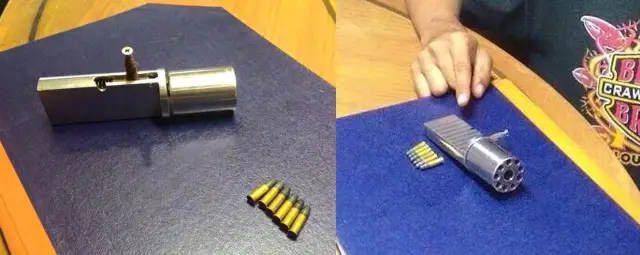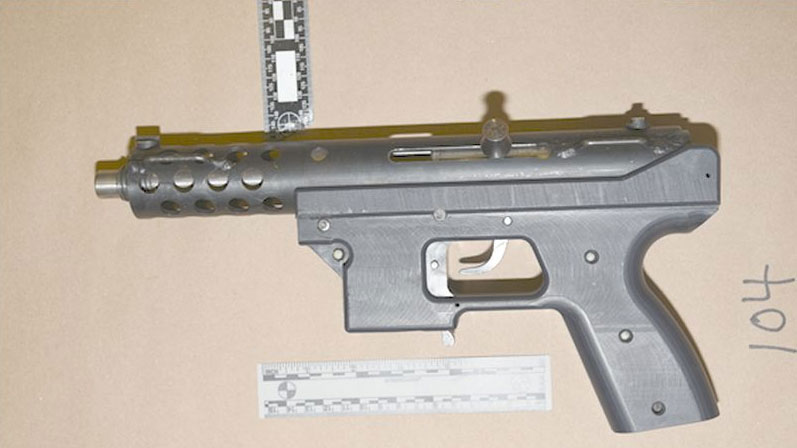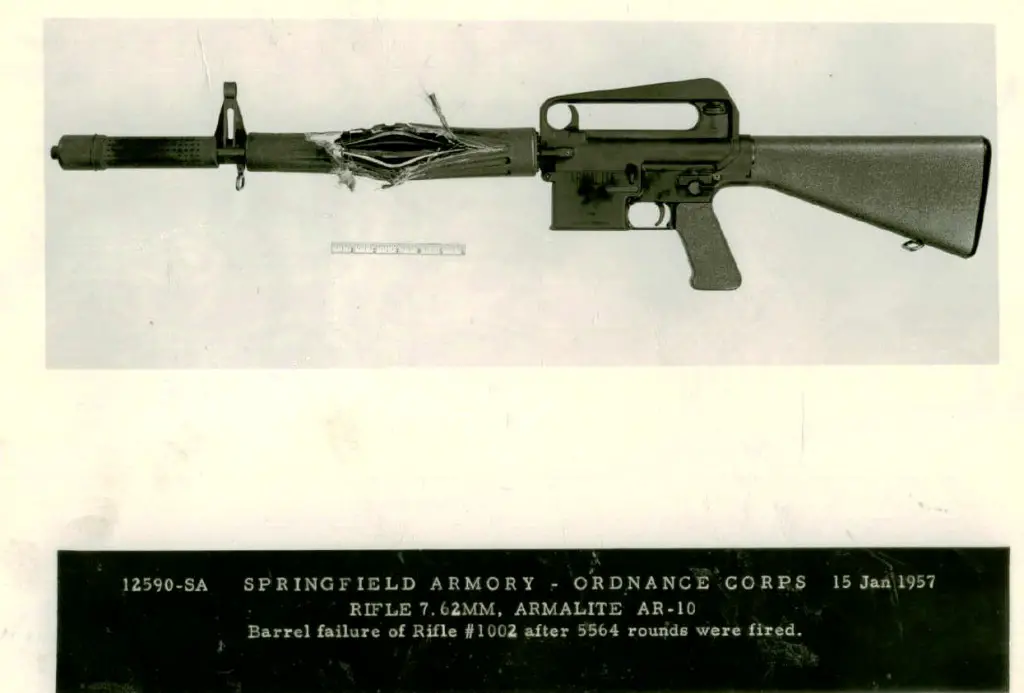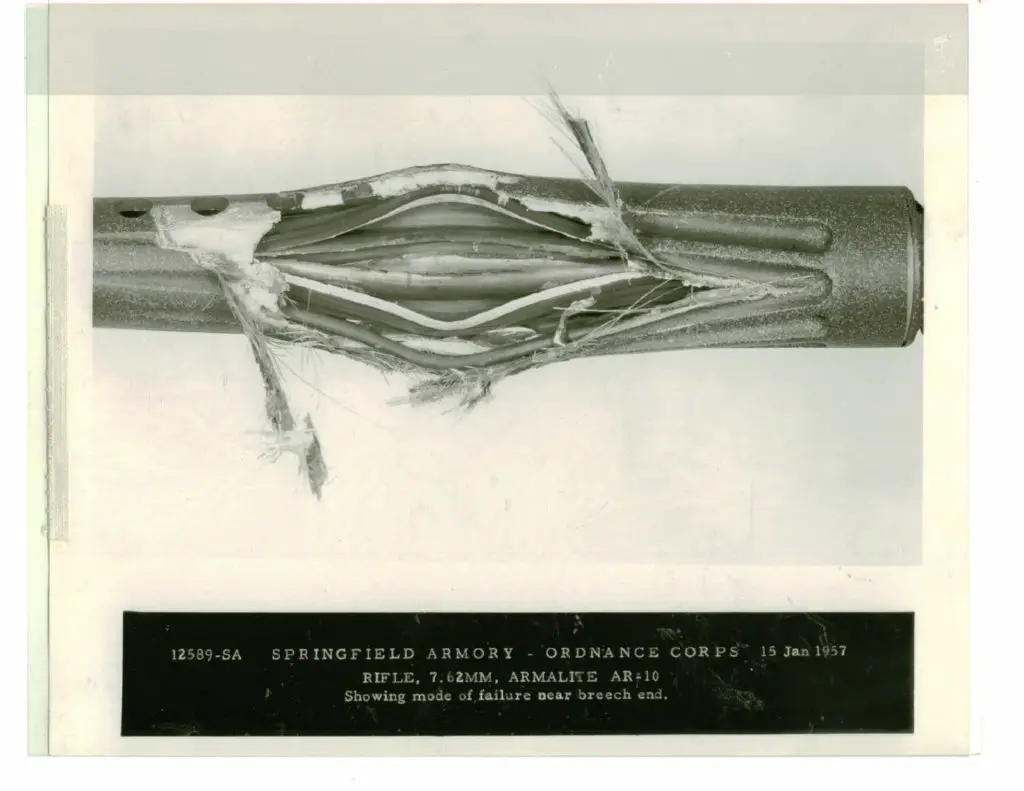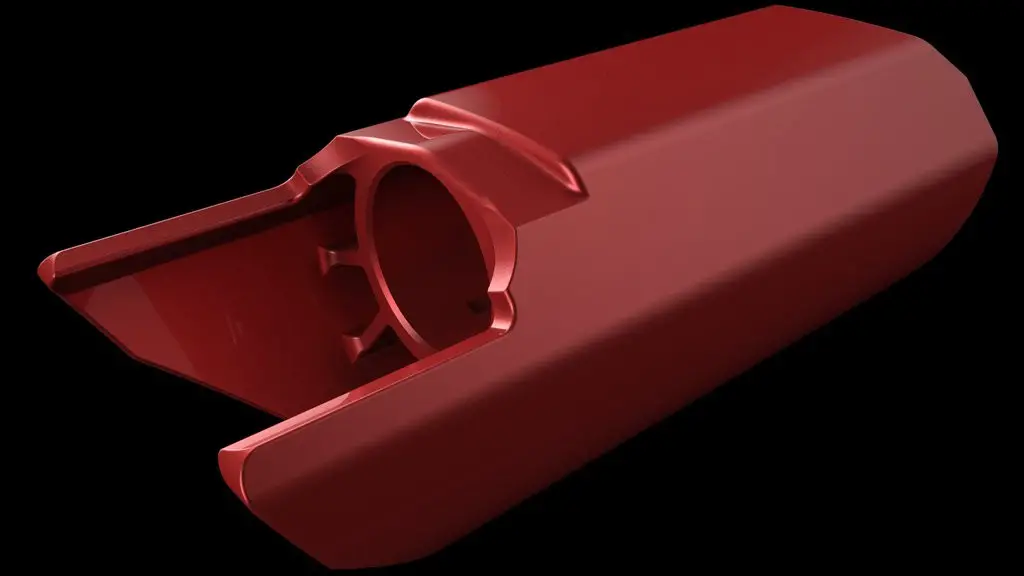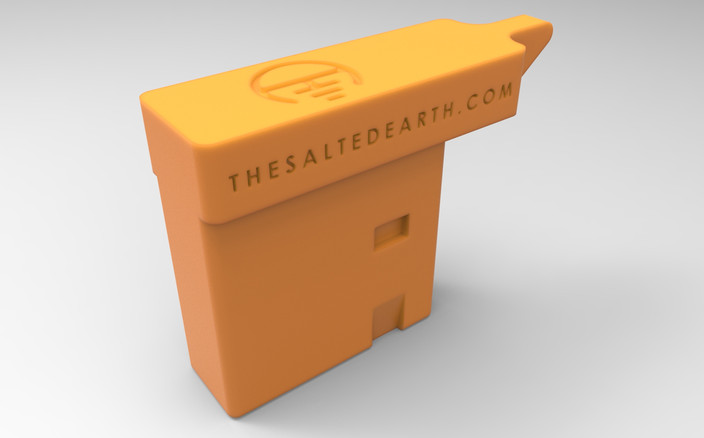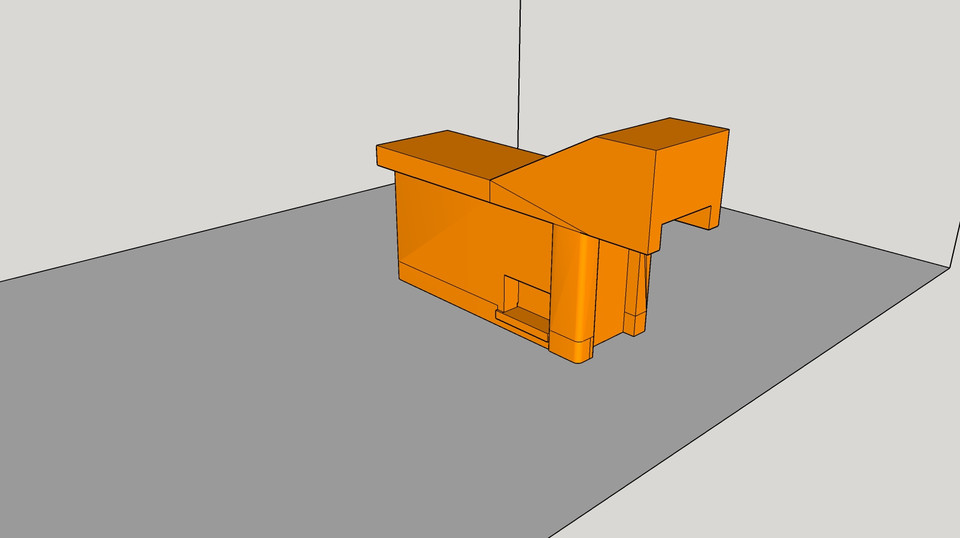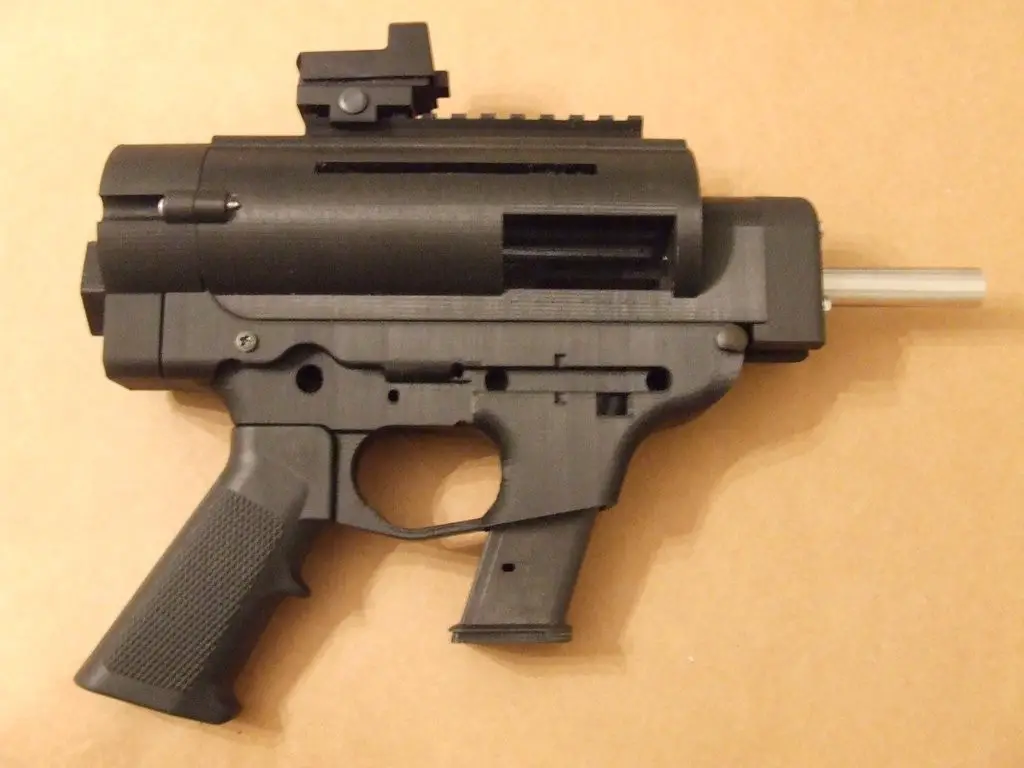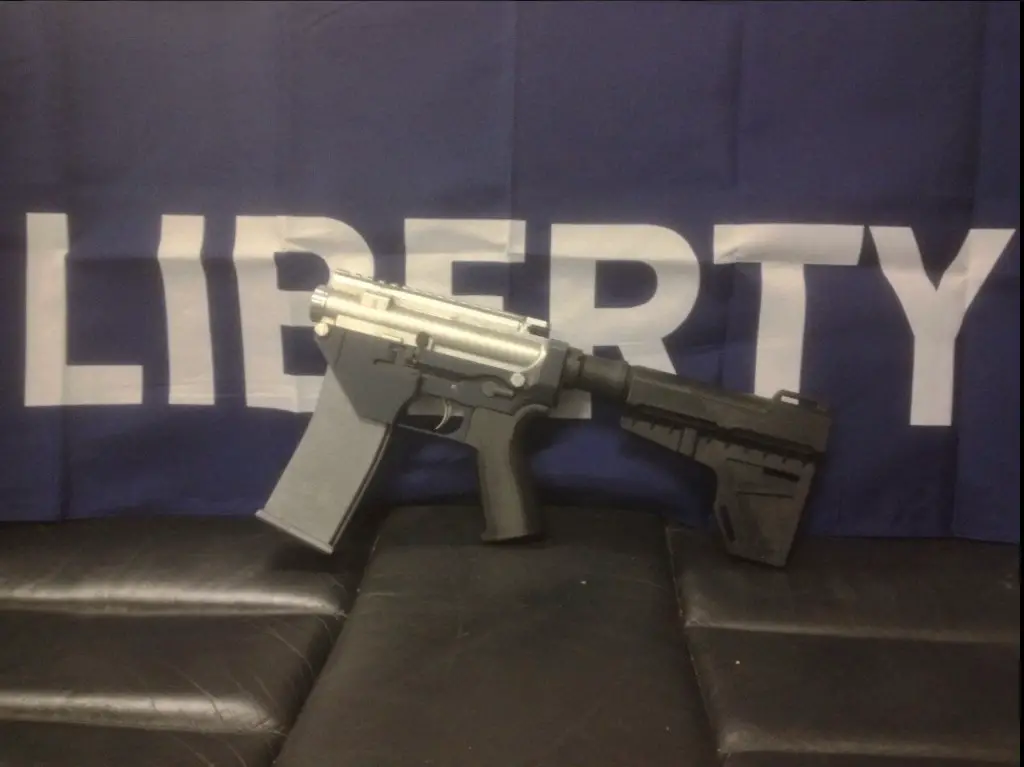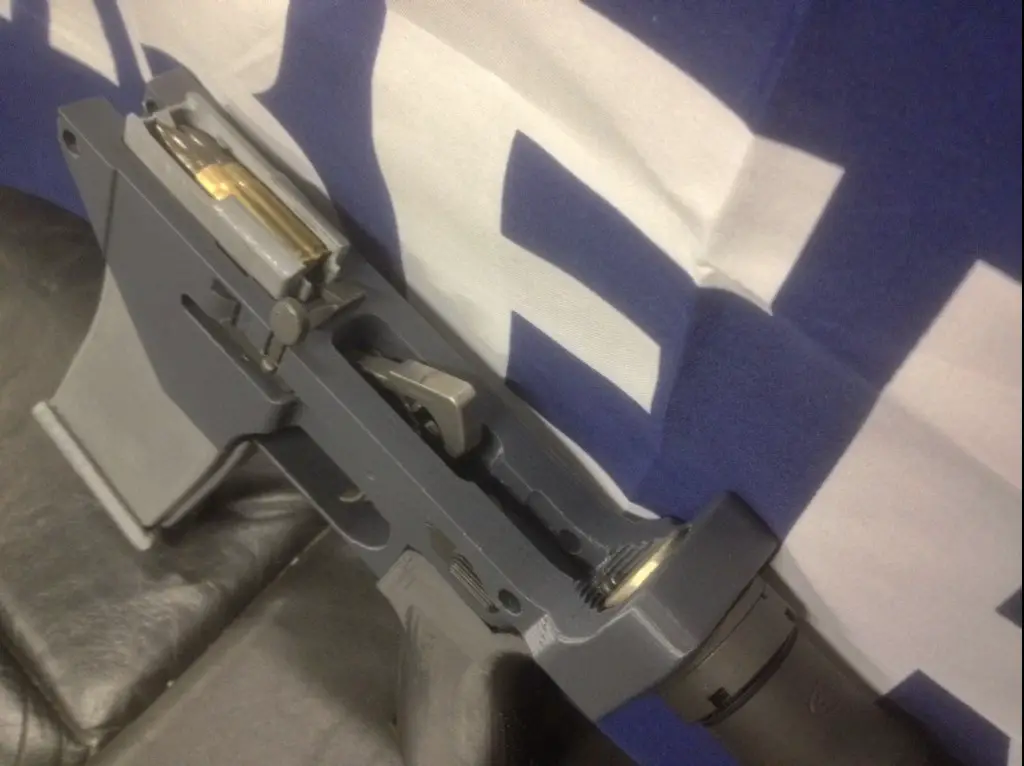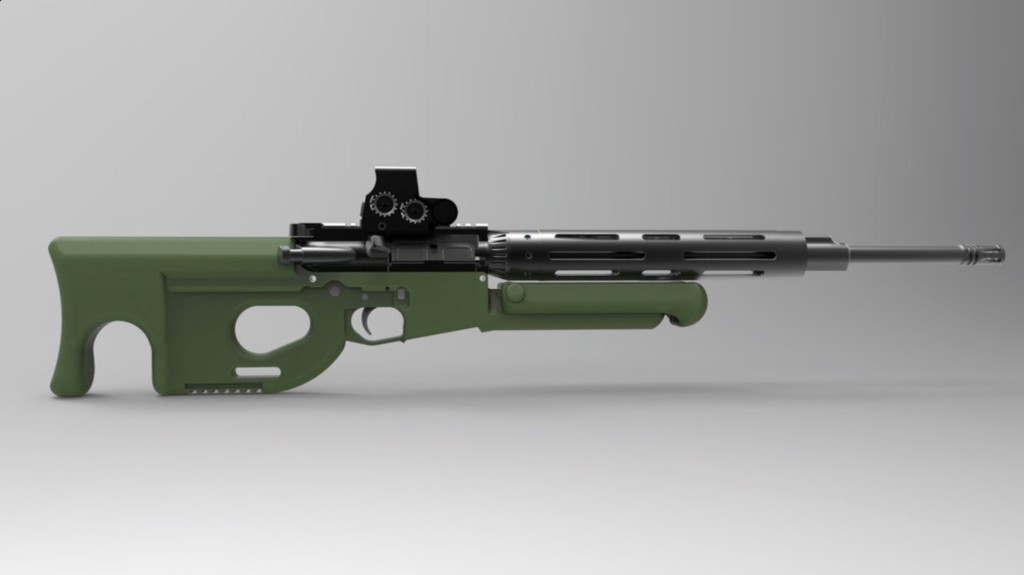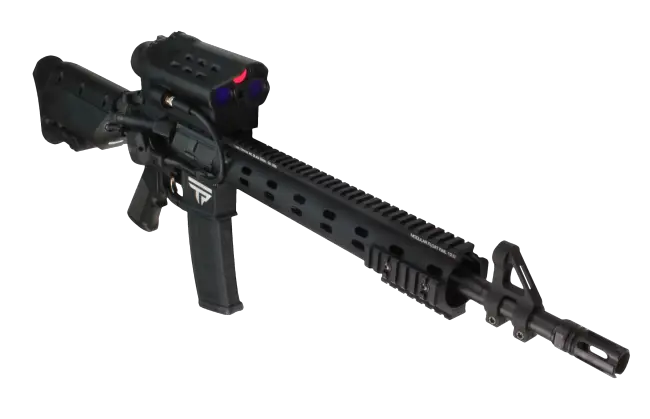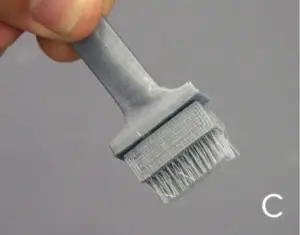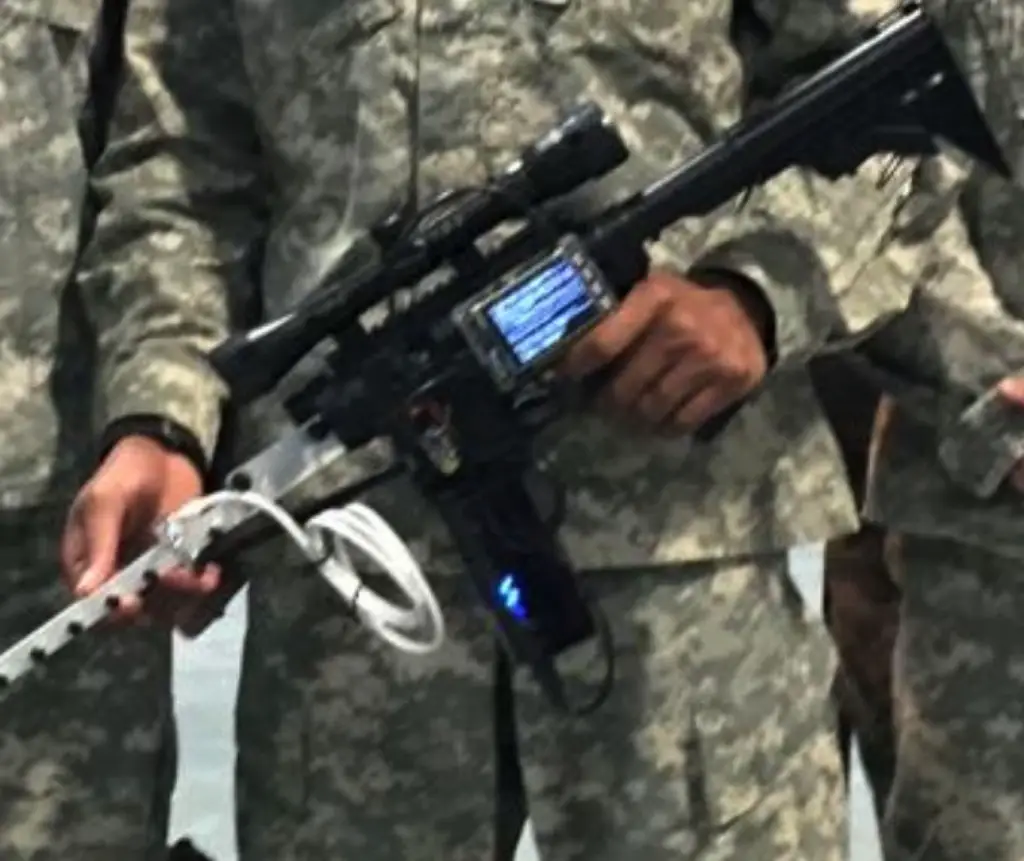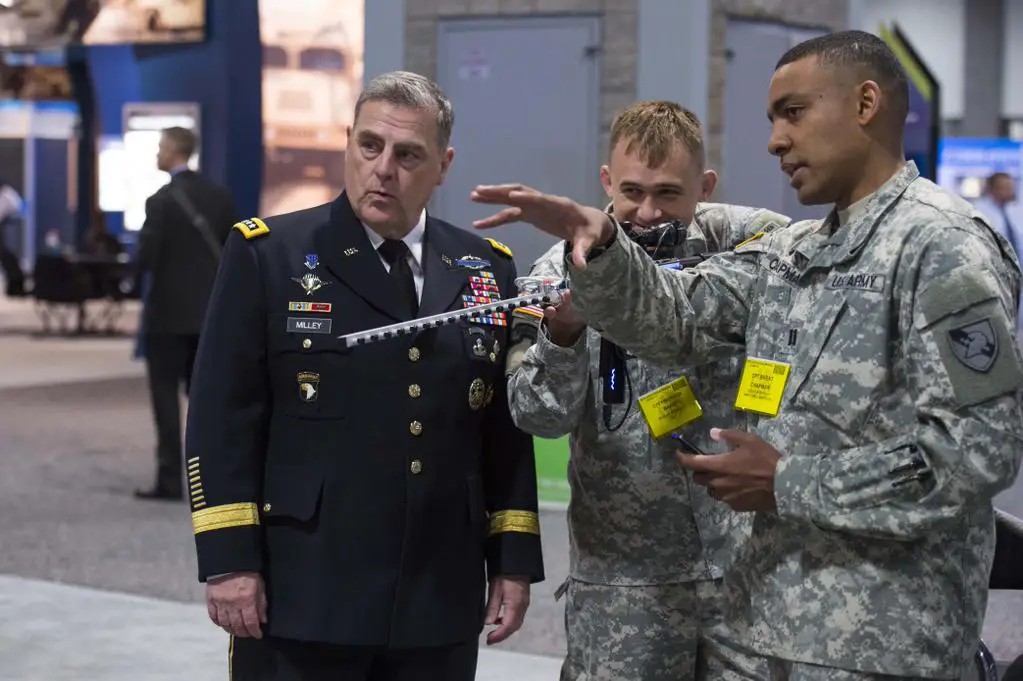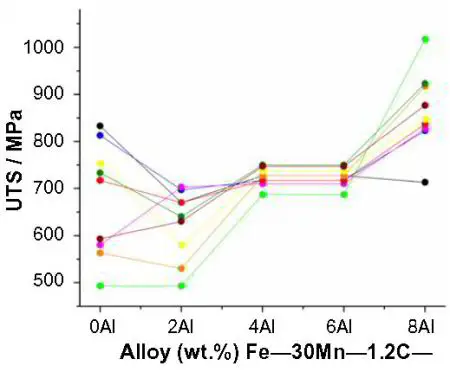Category Archives: Weapons of Tomorrow
We’ve had a few interesting developments in home and small office firearms prototyping lately.
The 3D Printing Revolution is Over, Part I
 In a way, the 3DP revolution is over. The revolutionaries won. Every firm in the industry that we have personal knowledge of, from the great (exchange-listed Ruger) to the small (single-digit prototype shops) is using 3D printing in prototype development or even in manufacturing. For example, Ruger’s investment-casting shop, which also casts for competitors and other third parties, Pine Tree Castings, is directly printing lost-wax patterns on two industrial printers; time, energy, and recycling effort are all signally reduced.
In a way, the 3DP revolution is over. The revolutionaries won. Every firm in the industry that we have personal knowledge of, from the great (exchange-listed Ruger) to the small (single-digit prototype shops) is using 3D printing in prototype development or even in manufacturing. For example, Ruger’s investment-casting shop, which also casts for competitors and other third parties, Pine Tree Castings, is directly printing lost-wax patterns on two industrial printers; time, energy, and recycling effort are all signally reduced.
The firms that are not using this technology are very small, practically one-man shops, and even they are often using 3D computer design tools and CNC. For the same reason that even the starving writer in his garret is hammering on computer keys and not his granddad’s Underwood: new tools have produced an explosion in individual productivity.
Productivity and Computer Technology
Computers directly enable productivity. For example, imagine this blog in the pre-computer (or even, pre-Internet) era. The “posts” or items would be typed on paper, then reproduced into a newsletter, and mailed to subscribers. It would lose immediacy and volume for sure; it would take us much more work to produce much less.
Computers also indirectly enable productivity by increasing information flow, both in terms of volume and rate. (An ironic by-product of that is that a whole new application for computers became necessary: tools to search, sort and amplify what is to any particular user his desired signal amidst all the noise (some of which is pure noise, but most of which is someone else’s desired signal). Economists have had great success in recent decades by describing economic activity in terms of flows, not of 18th-Century concepts like capital and labor, but of information. Freeing the flow of information from unnatural restrictions generally benefits the society and the individual. It usually scares the pants of some people, especially the ones who used to be able to control the flows.
Computers moved much more slowly into actual production of tangible products, but they’re there now, and making a similarly revolutionary change on the factory floor that Steve Jobs promised to “knowledge workers” in 1983-5 when he introduced the Apple Lisa and, later, the Macintosh Office. Some of those ideas misfired in their first implementation (early Lisas and Macs are collectors’ items today), but the marketplace iterated rapidly and effectively and still does.
Today’s computer manufacturing technology is still relatively primitive, when compared to its potential; we’re about where Steve’s “Macintosh Office” was 30 years ago.
Meanwhile, in Washington DC & Around the World
Just as manufacturing of products becomes disintermediated and dissociated from large integrating manufacturing/marketing/distribution organizations, we have our version of a Luddite spectacle. A bunch of politicians, most of them captive of the economic and political concepts of prior centuries, are making a childish display of themselves, and demanding restrictions on production and ownership of a product, firearms. But they are asking the impossible: guns can be produced under the most precarious of conditions by the most primitive of shops. They do this because they want to redirect anger and retribution away from the actual generator of the recent outrage, Wahhabi/Salafi Islam, and towards targets whose destruction they would find more personally gratifying.
The guy who last changed your brake pads and wiper blades probably has everything in his shop necessary to produce automatic weapons. In fact, another terrorist outrage you may not have heard about recently occurred in Israel where two assclowns inspired by Islam attacked a restaurant with submachine guns.
Back in February, more homebrew SMGs were used in attacks on Israeli cops.
The SMGs, made under embargo conditions in clandestine workshops in the lawless Palestinian territories, were improvised weapons. (One of which did fail during the attack. Testing is an aspect of manufacturing that technology can’t replace).
You certainly heard about the murder of left-leaning British politician Jo Cox, in the land of no handguns, Great Britain. Cox was killed with a crude improvised pistol based on an ancient US Army improvised guns manual.
Non-factory guns can be very sophisticated
Don’t take our word for it, just peruse the Impro Guns blog. Here’s a Thai pepperbox in .22LR.
This next picture is not a TEC-9. Take a good look! It’s a clandestine-shop knock-off open-bolt SMG, seized by cops in Canada last year. Restrict all guns and “prohibit” the scary ones, as Canadian laws do, and this is what anyone who wants a gun might as well build. He’s as well hung for a sheep as a lamb, eh?
Here’s a shot of Browning-style pistols produced in a one-house clandestine factory in Talcher, Odisha, India that was seized by police in the summer of 2015.
And here’s video of a (US, legal) home-built .25 pistol.
Here’s the build of the same (18 minutes). Tools used include a drill press, welding equipment and circular and saber saws. He does use some well-chosen cutting tools, like end mills and reamers, and uses a rifling machine of his own manufacture. ses At one point he improvises an end mill from a drill bit (per the plans he is using). He uses the name “Clinton Westwood” which we’re sure is what his mother named him; his YouTube Channel, Clinton’s Cheap Workshop, is full of must-watch TV.
Clinton’s new adventure is making a larger, 1911-styled .380 blowback pistol. He just started in April and has made good progress, so go to the YouTube channel, click Videos, and enjoy.
You might want to archive the videos, in case YouTube (which is owned by Google, which is either owned by or owns the Clinton — Hillary, not Westwood — campaign) disappears them and unpersons Westwood in the future.
The 3D Printing Revolution is Over, Part II
In another way, the 3DP revolution is over. Many of the revolutionaries of the first wave have gone much more quiet, perhaps because they’re involved in other things, or perhaps for some other reason. Maybe they’re under pressure from a lawless DOJ determined to find terrorists everywhere except among Islamic terrorists!
Cody Wilson? Tied up in a lawsuit, his new book, and the GhostGunner project. Now, the project isn’t idle. Here’s a new video posted this week on the GG2:
And the company released a new manual for the GG1 and GG2, and new software, on 1 June, including the first MacOS version of DDCut.
James R. Patrick? Website gone, although his .STLs have made it into the distribution. Have Blue? Hasn’t tweeted since December. Is he a Norwegian Have Blue, pining for the fjords? ArmaDelite? Not since April 7. Ma Deuce? Showing a heartbeat, at least. He posted a YouTube video in his channel about two months ago, for the first time in a year.
But RollaTroll is still with us (even if his last tweet was a Weaponsman link a couple weeks ago).
And the thing is, it doesn’t matter if some of the original founders of the 3D printed arms movement 3+ years ago have gone silent, gone Hollywood, gone to ground, or gone underground: a new generation is supplementing, and where necessary, replacing them. And the new generation is larger, and the generation they energize will be exponentially larger still.
The genie’s out, and anybody waving a bottle and muttering get-back-in incantations at this point just looks ridiculous.
We, for one, Welcome Our New Polymer Overlords
Let’s have another one from Guy in a Garage. In this case, he’s test-firing a James R Patrick Songbird .22.
You see some of the limitations of the 3D printed plastic firearm here.
But you also see some potential.
Barrels were never going to be the best test case for fused filament fabrication type 3D printing, for the same reason that even commercial manufacturers deeply committed to polymer firearms parts have never produced polymer barrels.
Polymer receivers go back almost 60 years to the Remington Nylon 66 (1959) and its derivatives, which had unitary receivers and stocks of DuPont Nylon 6/6, a polyamide that was then one of the toughest injection-moldable plastics available. Polymer handguns go back nearly almost 40 years — to 1979-82 and the development and launch of the Glock 17. Millions and millions of polymer frames have been made, but zero commercial polymer barrels.
There have been experimental barrels that were made of wound fiberglass, or fiberglass around a metallic rifled liner, such as the ones that Armalite of Hollywood, California experimented with for shotguns and some early AR-10 prototypes.
These early experiments left some of the Springfield greybeards wondering if Armalite was sourcing parts from Acme…
 …and having them installed by graduates of the Wile E. Coyote School of Gunsmithing.
…and having them installed by graduates of the Wile E. Coyote School of Gunsmithing.
Modern composite technology such as carbon fiber filament and tow, and filament winding machinery, has finally brought the technology into line with Armalite’s vision. Carbon fiber (lined, of course) barrels have also been adapted to modern rimfire arms as well.
What does this mean for the future of polymers? Well, it’s a fact that after all these years, good old Nylon 6/6 is still a competitive material for high impact uses. What has happened in the injection molding industry over that span of time is increasing use of inserts and overmolding to make molded parts out of multiple materials.
This is almost certainly the wave of the future — or one wave of the future — in 3D printed firearms parts. Many printers now have the capability to print in multiple materials or to pause for the insertion of an insert (such as a threaded socket for a screw; you’ve probably seen molded plastic parts with inserts like these).
We can still expect 3D printing to be used for convenience, short runs & micromanufacturing, customization and personalization, prototyping, making jigs and fixtures, and making molds and patterns for traditional manufacturing processes.
But if you really want to, you can make a gun out of it.
Silencerco SWR Radius Rangefinder
Silencerco says the objective of its Silencerco Weapons Research subsidiary is “to bring advanced technology to the public at an attainable price.” We had not heard of that, or of SWR for that matter, until they came up claiming mission accomplished: “with the announcement of a capability-heavy range finder for only $999, we’ve done just that.”
Have they? Here’s a silent (apart from music and maybe gunshots) video of the SWR Radius in action.
This video describes some of the capabilities:
Sure, it’s not TrackingPoint, but TrackingPoint is not available for pre-order at $995, either.
The Tracking Point system includes several other modules, such as an air data computer that accounts for atmospherics (density, ambient pressure, altitude, temperature), a ballistics computer that knows the bullet performance at a given range, an aiming point module that adjusts the digital reticle on to target, a target reference module that “understands” where a marked (“tagged”) target is in three dimensions, and trigger control that, in a digital update to the way a Contstantinesco gear interrupted fire of a World War I fighter plane unless the propeller was clear of the trajectory, only allows the trigger to fire when the aimpoint is on target.
A unit like this, if it were able to output data through an RS232/RS422 port or something like that, could be a component of such a system, and if the rangefinder alone succeeds, the likelihood that SWR builds in this direction is increased.
Of course, the one nut that even TrackingPoint has yet to crack is wind.
None of these developments are really, in the truest sense of the word, inventions. They’ve all been around for a century, manually calculated and optically ranged, in naval gunnery, and for most of a half century (including laser ranging) in tank gunnery. The new development is this technology reaching levels of portability and affordability where it can be installed on (or in) an individual weapon.
There are couple less in-your-face developments embedded in the Radius. One of these is the display of not just one, but the top three range returns. This is a big deal if you’re engaging a target screened by vegetation, a chain link fence, or any of the other embuggerments that give a laser rangefinder a false return.
Another is the selectable use of visible and IR laser. The two lasers coalign, so that the laser can be boresighted or sighted-in with the visible laser, and then switch to the IR for actual field use, and use it with confidence.
This suggests that, while full firing system integration à la TrackingPoint is one way this can go, there are other ways. For example, a unit integrating this laser capability (in milspec strength) with current IR/visible laser floodlight and point illumination would be catnip to the military services.
How would you use this? No manual is posted yet, but a .pdf spec sheet is available.
And as an exit video: here, they’re hinting at some future capabilities.
Dude, where’s my jetpack?
3D Update for 8 April 2016
Here’s a few things that may be useful or entertaining to people working with, exploring, or just interested in this technology.
AR-15 Printed Lower: Print Bed to Ready to Load in 20 min
This video shows what appears to be the real time assembly of a FOSSCAD Vanguard lower from the print bed to a complete (if sightless) AR.
We’d quibble about some of his shortcuts and techniques — no, a piece of copper wire is not a suitable substitute for a roll pin, and while it’s neat that he used 3D printed pivot and takedown pins, how are they retained? Oh, they’re not — but we’ve been telling you for years that this technology was maturing, and now we’re showing you.
We suspect this fellow’s channel is going to be worth watching in the future.
Shuty MP-1 by Derwood Night Fire (10 sec. video).
We’ve discussed the gun before, here’s a video of it shooting at night.
Unlike his earlier versions of the Shuty, Derwood won’t be publishing these files on SendSpace. He also notes that the MP-1 still is limited; 18 rounds is all it takes to soften the thermoplastic around the barrel. Of course, he’s already working on improvements, as an intellectual exercise in home workshop engineering.
The media reaction to his firearm has been… interesting. Even 3D Printing industry journalists are journalists at heart, and can’t see this except through the prism of their anti-gun politics. For example, Benedict at 3Ders.org tut-tuts that “the relatively new phenomenon of open-source, downloadable firearms seems to promise a greater deal of harm than good,” whines that, “the maker circumvented all gun control laws, creating a totally legal weapon without so much as an ID check,” and closes with, “So is it sensible to put lethal weapons in the hands of all and sundry with an internet connection and 3D printer?” Andy Greenberg at Wired, long prone to involuntary incontinence in his Aeron over this issue, hyperventilates similarly: “Deadly, working guns that anyone can generate with a download,” that have “spooked gun control advocates” — those unnamed “gun control advocates” being named, naturally, “Andy Greenberg” — and “successfully circumvented all gun control laws”. Our only question to Benedict and Greenberg is, “With your string of pearls in one hand and your blankie in the other, how do you type your articles?”
3D Printed Rimfire Stuff
We had been unaware of the 3D action over on RimfireCentral.com, a membership forum. Lots of 3DP based threads there, including:
- A 3D Printed stock for a Ruger Charger pistol (above)
- A 3DP Receiver for a 10/22.
- An action block for free-floating a barreled action for benchrest competion.
- A printable magazine speedloader for Ruger Mk II and III pistols.
- A couple of accessories for a Remington 597 (the page has links to the files)
- 3D printing magazines for Izmash 7-2 .22 and .22 WMR biathlon rifles from Russia that are embargoed (see also this page).
Spud Gun Camera Module
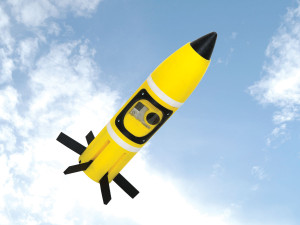 Now we get silly. Here’s a “projectile” that lets you fire a GoPro camera from a spud gun and recover the camera, rather than see it dashed to pieces. Well-engineered, with spring-loaded stabilizing fins just like “real” FS smoothbore rounds. You’re on your own for more martial applications, and mind the Destructive Device laws.
Now we get silly. Here’s a “projectile” that lets you fire a GoPro camera from a spud gun and recover the camera, rather than see it dashed to pieces. Well-engineered, with spring-loaded stabilizing fins just like “real” FS smoothbore rounds. You’re on your own for more martial applications, and mind the Destructive Device laws.
Yes, this is very silly. And?
Mark One Reinforced Printing
This is the Mark One in action. This is not ours, it’s Sumdood’s, but we finally have time to work on ours this week! The Mark Two is even cooler as it can winkle the reinforcing fiber into smaller areas… the Mark One can’t turn the reinforcing around a corner any smaller than the size of a quarter.
Exotic Fibers for Everyday Printers
Of course, the Mark Forged printers require proprietary fibers. But exotic fibers are becoming available to open-source printer users as well. Here’s an enthusiastic young Australian named Angus showing off a quadcopter frame with arms of four different materials: common ABS and PLA, and exotic Thermoplastic Polyurethane (rubbery) and Colorfabb Carbon Fiber (rigid).
One of Angus’s really good ideas: using a raft of ABS as the basis for the exotic print. (A “raft” is an expendable base laid down underneath the “money” print). The sales page for the TPU says don’t use rafts, and that’s because they mean, rafts of TPU. He also didn’t heed the warning about using steel nozzles with the carbon fiber, and he explains why.
Instead of laying continuous fiber reinforcement like the Mark Forged printers, the Colorfabb XT-CF20 “Carbon Fiber” filament seems to have sort of chopper gun microfilaments in it. The trade off is less reinforcement strength vs. more flexibility of employment.
Of course, the Mark Forged printers also use nylon as their basic material. Nylon. as we have seen, has significant advantages over PLA or ABS. (One of the nicest things about it is it does not emit a noxious smell).
Check out his channel, Maker’s Muse, it’s full of interesting stuff. He also has a video on “metal” filaments that you may have seen advertised.
Taulman3D Materials
Speaking of materials, especially nylon variations, but also a “better” PLA and an elastomer, all kinds of new stuff from taulman3D. Lots of horses for lots of courses there, and that link’s just their new stuff.
Update
Know those Shuty 4.0 MP-1 files that derwood wasn’t going to release? Well, he didn’t, but….
Some 3D Printed Firearms Updates
It’s been a long time since we did one of these updates, so here are a few things we’ve picked up here and there.
Print Now, Rest Later
Here’s a practical print task: a 3D printable cheek rest for an AR-15 pistol. (Well, to the extent that an AR pistol is practical). As we understand it, if you shoulder the weapon (say, with a SIG brace) you are violating the SBR laws, but if you’re cheek-resting you’re all tickety-boo. This image is a rendering; a final print will have some striations to it, from most printers using the most common 3DP technologies.
Checked as of last night, the files are here: https://www.sendspace.com/file/386tvq
Happy printing & shooting.
About those striated parts
One of the problems with 3D printing, especially the Fused Filament Fabrication / Fused Deposition Molding type that is common, is that the parts often display layering, striations, and other artifacts that add up to a lousy surface finish. There are several ways to smooth 3D prints.
These include:
- Mechanical Smoothing — this can be sanding or particle blasting; each has its pros and cons. Sanding is limited in how small a part you can do, bead blasting in how large. Bead blasting always produces a matte finish, although the coarseness or fineness of the finish depends on the blasting media. On a part large enough to be practically sanded, sanding can produce a finish limited primarily by time and the cost of skilled labor.
- Chemical Solvent Smoothing — this involves exposing the part to solvent vapor. For example, for ABS, acetone vapor either cold or hot (hot vapor has definite safety limitations and concerns, but can produce a superior finish). Acetone doesn’t work with PLA as it’s not acetone-soluble. Acetone also reduces the strength of the part: its stiffness is reduced, and it fails under a lower load.
- Finish Coating — for a cosmetic finish, a thick paint can be used to fill layer striations. This will, often enough, loop you back to sanding. This is cosmetic only and subject to wear.
- Epoxy Coating — this does require some skill to pull off, but both fills and reinforces the part. This can be important with some liquid-based and powder-based laser 3D printers whose parts tend to be brittle; coating them with epoxy can make the printed part, in effect, a shear web and form inside a tough, flexible epoxy shell. This is good when the part needs to be employed as is, and not so good if the part is intended to be, say, a sacrificial casting pattern. (In that case, for lost-PLA casting for example, use one of the other procedures). Smooth-on sells an epoxy that’s optimized for this type of use and has several how-to and application videos on the web page.
For more information:
- Lindsey Frick in Machine Design on “How to Smooth 3D-Printed Parts.”
- Smooth-on’s gaudy page on their XTC-3D 3D Print Coating has lots of examples and tutorials.
- Here’s Make Magazine and Instructables with a pair of acetone-vapor tutorials.
- And here’s the story of a guy who went whole hog and built an ultrasonic vapor fogging chamber in hopes it would increase the strength of his prints (it actually weakened them). There’s a link in that article to an Instructable on building his fogger, too.
100 Rounds from a 3DP Pistol
Remember the original Liberator (well, the original 3D Printed Liberator, not the original original Liberator)? It was only good for a few shots. (Unless you were the New South Wales Police, and printed it without reading the instructions, in which case it blew up first shot). What use was it? But as Franklin said on being asked that of the invention of the French aeronauts, the Montgolfier brothers, “What use is a newborn baby?”
Well, here’s a 3D Printed pistol that has fired 100 rounds and is still going. 3D printed AR lowers long ago beat that number, but here’s a pistol that’s all 3D printed on consumer equipment, except for the mandatory weight and firing pin.
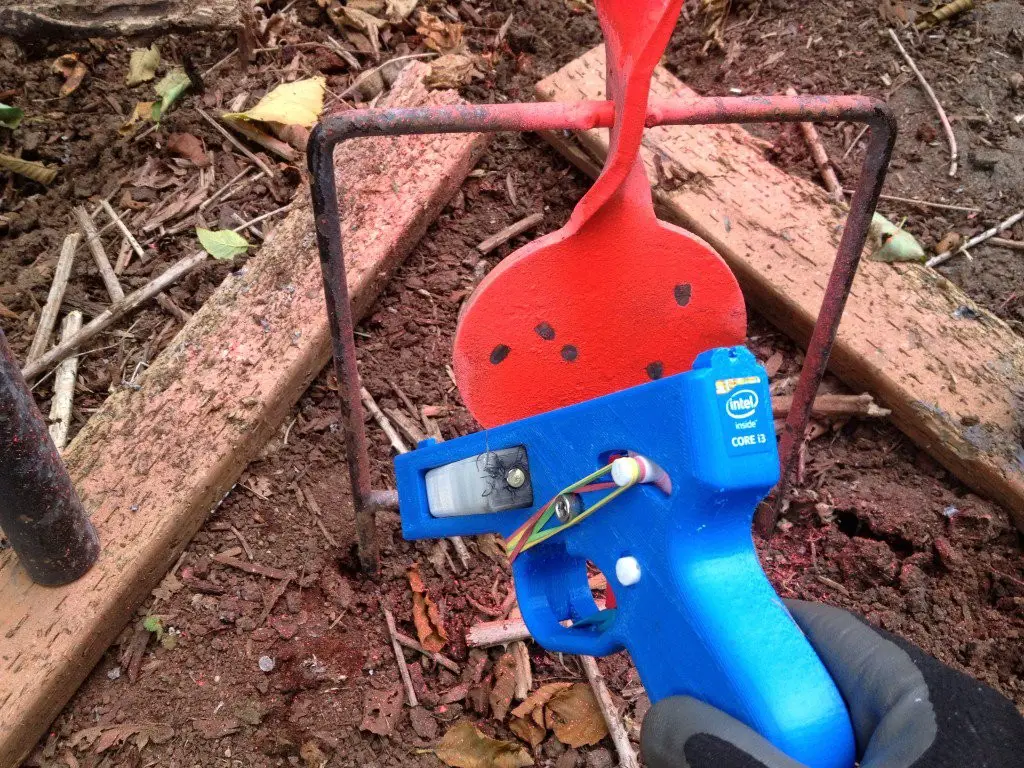 We’re not sure whether this colorful print of this James R. Patrick design wants to be a toy, or whether it wants to be a Glock when it grows up.
We’re not sure whether this colorful print of this James R. Patrick design wants to be a toy, or whether it wants to be a Glock when it grows up.
A Practical Print for Almost Everyone
What’s this? It’s an AR Hammer Block. Use it when you want to function-check that lower you just monkeyed with, without running aground on the Scylla of letting the hammer slam into your expensive piece of aluminum (very expensive if it comes with a stamp), and the Charybdis of using your delicate pink (brown, whatever) thumb to intercept the falling hammer.
A great, practical print. (The website it’s advertising is for a training device to use with your SIRT, not available to the general public yet). Hmmm… the “files” link at PrintedFirearm.com, went to a malware site: adf.ly! And downloaded a malware .exe! We’re not giving you that link.
OK, here’s another one instead, by Charles Lacey:
Files here, Grabcad is not a malware site: https://grabcad.com/library/ar-15-trigger-pull-test-block-all-set-for-3d-printing-1 (You do have to join Grabcad to download files, though).
Lacey also has a chamber flag, or as he calls it, a bore flag, on Grabcad, and a couple of Magpul mag floor plates, including a whimsical Flying Tigers version. We leave finding those as an exercise for the reader.
Large Format Printed Pistol Now Speaks Glock
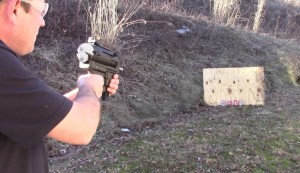 We’ve showed the Shuty MP-1 before, a 3D printed pistol inspired by the designs of Luty. The pistol made a splash in the media some time ago, with the usual alarums and excursions, dogs and cats lying down together, and all the usual drivel you usually only hear in an election year. (This happened twice, actually — in February 2015 with the original Shuty, and in February 2016 with the improved MP-1).
We’ve showed the Shuty MP-1 before, a 3D printed pistol inspired by the designs of Luty. The pistol made a splash in the media some time ago, with the usual alarums and excursions, dogs and cats lying down together, and all the usual drivel you usually only hear in an election year. (This happened twice, actually — in February 2015 with the original Shuty, and in February 2016 with the improved MP-1).
Less publicized has been the Gluty — as you can see from the image below, it’s a Shuty reengineered for Glock mags. The image tells us it’s been printed but we’re not aware of how successfully it has been test fired — unlike the Shuty.
One of the biggest limitations of the Shuty is its magazine. Adapting to commodity Glock magazines is the easiest way to increase the magazine capacity of this novel firearm. At the same time, the original files, with their included magazine files, allow the creation of a firearm where even the mags are unobtainable.
Of course, that still leaves the barrel as a tough nut to crack. Shuty and Gluty use the standard pistol barrels.
Printed AR Lower
This FOSSCAD JT Vanguard has been around for a while. This recent print, in ABS thermoplastic, shows some of the strengths of the design, and how the venerable AR form factor has had to change to adapt to these new materials and new processes. First shot shows it with an upper in the white. The grip and magazine are also printed.
The grip is also ABS. We’re not sure about the materials of the mag, and wonder if the buttstock is printed also. This next picture shows you just a few of the changes, including the bulkier pivot area, the much beefier buffer tower, and the thick reinforcements along the receiver outboard of the trigger group.
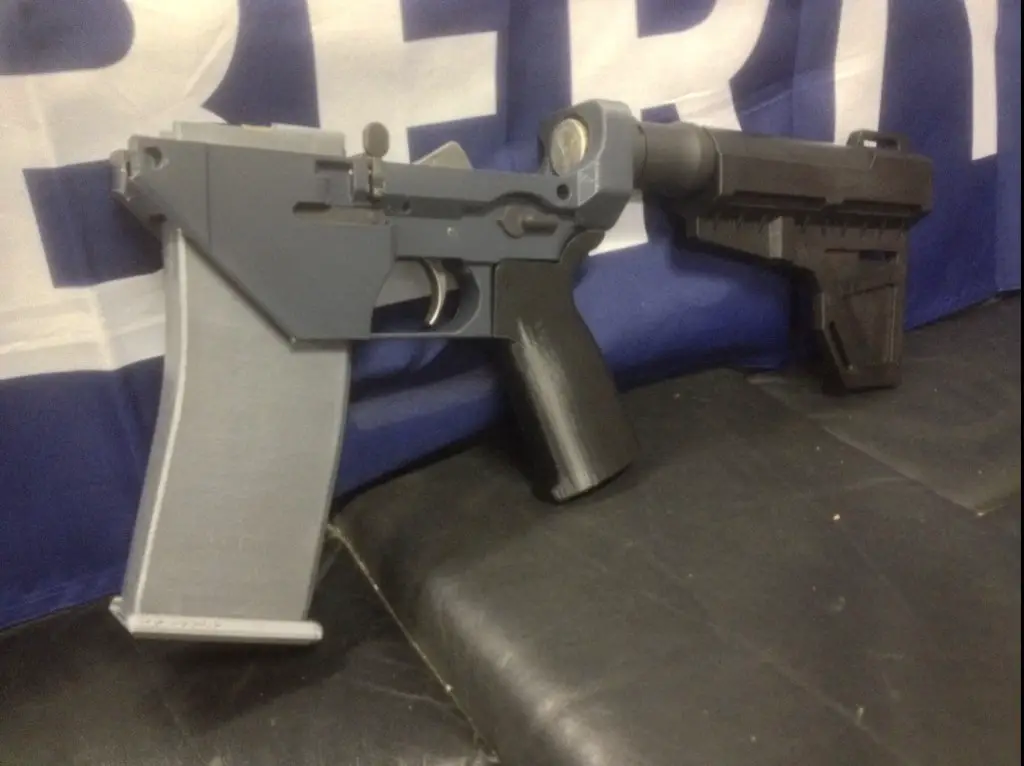 This picture shows the trigger group in place. The reinforcement is clearly visible.
This picture shows the trigger group in place. The reinforcement is clearly visible.
There have been experiments with printed trigger-group components, but so far, they haven’t been very impressive. Materials and processes need further improvements.
Exotic Lower-stock Bipod Combination
This is the Atlas AR-15 lower, by WarFairy CAD. It has a certain FN P90 vibe to it. It’s meant to be used with a free-floating barrel and suitable handguard/rails system.
When one looks at some of these designs, one is reminded of Donald Sutherland’s character in The Dirty Dozen, impersonating a general. “Pretty, but can it fight?”
Atlas Files: https://www.sendspace.com/file/6f0cfo
Finally — MakerBot Hates You
MakerBot continues its extreme antigun position. How extreme? A design for a powder knob for a Dillon progressive reloader was banished to 404.
Funny, their 404 page says, “There is nothing awesome here… yet.” Well, there was before they deleted it!
MakerBot does not want our business? Transmission received.
Consider Ultimaker. Ultimaker advertises on PrintedFirearm.com, which is an interesting site to check from time to time. Beware of any of their links to adf.ly. Two we observed were both delivering malware yesterday, and probably still are.
Tracking Point. .300 BLK. Night Capable. $6995.
They’re positioning the new Tracking Point NightHawk as a Homestead Defense gun, but we’re seeing the king of all hog harvesters.
This latest iteration of TP tech is supposed to list at a that’s-what-my-truck-cost $15.5k or so, but they’re jump-starting sales by selling the first 100 for $6995. Tracking Point writes:
The… NightHawk .300 Blackout. Designed for homestead defense, NightHawk has a fully integrated night vision capability and is offered at an introductory price of $6995 for the first 100 purchases – the lowest price ever offered for a Precision-Guided Firearm.
To us, the NightHawk seems like a slightly-decontented .300 version of their 5.56 M600 SR service rifle. Unlike the M600, the NightHawk is limited to engaging targets at speeds of 7 mph.
A follow-up email had more on the special offer:
The TrackingPoint team would like to thank everyone for a tremendous response to our NightHawk product launch. We were overwhelmed by the genuine interest in our night vision system designed for homestead defense. The NightHawks have literally been soaring off the shelves!
“Literally soaring?” What, it’s a drone, too? Or is Vice President Biden, the National Mangler of “Literally,” writing TrackingPoint’s ad copy these days?
This is a notification that we have a limited supply of the first 100 NightHawks for the exclusive offer price of $6,995*. Place your order today to guarantee this discounted price and receive the most advanced Precision-Guided Firearm to date for the lowest price ever offered.
To place an order, please call (512) 354-2114
*MSRP $15,490
Tracking Point also offers financing now, which may make some of their pricy firearms more accessible to regular Joes. $7k is a lot for an AR, but considering that the scope and night vision are included, the delta between NightHawk and a build-it-yourself day/night rig is not as big as it seems at first.
Technically, the night vision is an add-on to the TrackingPoint system that uses an infrared illuminator (as in early active night-vision products, like the M3 Carbine and Infrared Snooperscope, or the infrared driving light on a 1960s Russian tank), but they claim it gives Generation II equivalent performance. The night vision capability is available as an option (including as a retrofit) for the rest of the TrackingPoint line. Here’s what they say about it:
NightHawk includes fully integrated Night Vision Kit which enables CMOS sensor technology to deliver Gen2-like night vision performance. After dark you are able to acquire and track targets just as you would in daylight. Nighthawk also includes a rail-mounted IR Illuminator.
Also, in a first as far as we know, the NightHawk has programs for TrackingPoint branded ammunition but also off-the-shelf ammunition using the Barnes 110 bullet. Previous TrackingPoint precision guided firearms have required TrackingPoint ammunition for predictable ballistic performance.
Other new capabilities (or perhaps, new description of an old capability) include a mode making the “tag” on a target automatically seek center of mass on that target, and using the TrackingPoint precision-guided system to enable image-stabilized shots from offhand to provide “firing supported” levels of precision and accuracy. The tagging system and guided trigger also increases hit probability on moving targets or on shot at stationary targets while shooting on the move.
The one question still open in our mind is this: how does it fare with a suppressor? Seems to be leaving a signature capability of 300 BLK behind, if it’s not suppressor-ready and can’t account for the point-of-impact shift that comes with most suppressors.
More information on the NightHawk is available on TrackingPoint’s website.
“The Soldier got a good cheek weld on the soft, warm fur of the stock.”
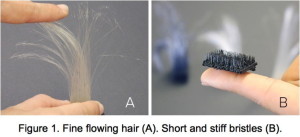 Science fiction? Right now it is, but it’s now science fact that it’s possible to add integral hair to 3D-printed items. Scientists at Carnegie Mellon University illustrated this using the most common form of plastic 3D printing, fused deposition modeling (also called Fused Filament Fabrication by some vendors).
Science fiction? Right now it is, but it’s now science fact that it’s possible to add integral hair to 3D-printed items. Scientists at Carnegie Mellon University illustrated this using the most common form of plastic 3D printing, fused deposition modeling (also called Fused Filament Fabrication by some vendors).
They can make short, thick, rigid bristles, or soft, downy hair. The result makes hairs, fibers or bristles that taper naturally, almost organically, to a point. They write:
In this work, we introduce a technique for 3D printing soft strands, fibers, and bristles (Figure 1), using conventional fused deposition modeling (FDM). Our work was inspired by the peculiar phenomenon that occurs during the opera- tion of a handheld glue gun: when a person extrudes hot glue material and moves the gun away, a “string” of residue often forms unintentionally (Figure 2). The shape, length, and thickness of the resulting stringy material varies based on how much glue was extruded and how fast the user moves away from the extrusion point. This artifact often annoys users, but in this work, we exploit the phenomenon.
The scientists, Gierad Laput, Xiang ‘Anthony’ Chen, and Chris Harrison came at the problem from a human-computer interaction background and approach (they all work at CMU’s Human-Computer Interaction Institute).
They did not use a high-end printer, but achieved their results with a Printrbot Simple, a ~$350 kit printer. They found that one way or another they could control the density, length, thickness, color, and distribution of the hairs or fibers. The hairs are also amenable to many kinds of post-processing. For the best results, they extrude the hairs horizontally, in the X or Y axis.
You can easily imagine some potential future developments, like a bespoke “hair” extruder that would lay down an array of hairs at once. Laput, Chen and Harrison have demonstrated the concept; now it’s up to the rest of the world to reduce it to practical applications.
Like a fur-bearing rifle stock. That’s perfectly and individually sculpted to your cheek weld.
They have also named the process: furbrication. Perfect!
The pre-publication paper (it is to be presented at a conference this month) is here on Laput’s server. Hat tip, Caleb Garling at MIT Technology Review.
There are people who are not in the gun culture that think we are too attached to our firearms now. What’s going to happen when our guns are as soft and warm as a cuddly bunny?
Cyber Gun Aimed at Low-Information Generals
This image comes to you from the US Cyber Command’s booth at the AUSA convention, basically like SHOT show for the Army, complete with a keyword where the Chief of Staff sets the tone and introduces the buzzwords for the next year.
Wuzzzat he’s holding? A phased pulse rifle in the 40-megawatt range? Not exactly. This year, the Chief’s thunder has been stolen by that futuristic gadget, the Cyber Rifle. It’s a promotional gimmick from — who else? — the Army Cyber Institute at West Point. Appropriately enough it has been promoted by tweet.
It can open doors!
ACI demos low-cost, rapid-build cyber rifle in stealthy breach of bunker w/ automated light & lock #AUSA2015 @ARCYBER pic.twitter.com/UyOxafXG1O
— Army Cyber Institute (@ArmyCyberInst) October 12, 2015
And zap drones! (If the Army gig doesn’t work out, they could sell this thing to every celebrity wedding planner from Malibu to Montauk).
ACI uses a field expedient cyber tool to disable an enemy mobile observation post (quadcopter) @AUSAorg @ARCYBER pic.twitter.com/zl1m3hELQl
— Army Cyber Institute (@ArmyCyberInst) October 12, 2015
The Cyber Gun isn’t a real weapon, although as you can see from the close-up, it’s built on AR-15 receivers. It’s more of a technology demonstrator, but even more than that, it’s a capabilities briefing in memorable, physical form. Captain Brent Chapman (the grinning fellow wielding the “rifle” in the “bunker lights and door” video) built it from COTS components, including a Raspberry Pi1, Wi-Fi module2, Kali Linux3, and Yagi antenna4 (since those may be terra incognita to some of our more firearm-oriented readers, there are definitions in the notes). It cost $150 to buy the parts, and 10 hours to build and test the Cyber Rifle.
Captain Chapman wasn’t entirely breaking new ground here. A very similar rig, made for mobile penetration testing, is in this 2013 blog post. Of course, it doesn’t look like a rifle.
So why does the Cyber Rifle, which is really a simple computer running some hacking tools with an antenna, look like a rifle?
Well, we mentioned how the Chief of Staff uses his speech to give impetus to ethe Army’s newest, shiniest buzzwords. No buzzword is shinier, now, than cyber. The Army has created a Cyber Branch (it took 35 years for SF to get a branch, but we didn’t offer the possibility of non-fighting slots for Academy grads that incline that way), and has selected its initial cadre of officers and NCOs. And here’s how we know that cyber’s a big deal with this Chief of Staff:
That’s the new boss, Mark Milley, in the Army Blue uniform, an outfit that looks like it’s on loan from the guards at Lenin’s Tomb. (He’s got a lot of sparkly baubles. Which one is the Hero of Socialist Labor?). Gen. Milley looks a bit bemused by the whole thing, but cyber is big with Big Green (source).
One of the many stories written about the Cyber Rifle in the last few days hints at the reason:
All of the tech was placed onto the rifle frame, making it easier for senior military leaders to appreciate.
“Easier for senior leaders to appreciate…” gee, that sounds a lot like “Generals are thick, make it look like a rifle or they’ll never understand how a computer can be an offensive weapon.”
But they wouldn’t really say that, would they?
Well, here’s another story with a quote from Capt. Brent Chapman:
The rifle shape, meanwhile, is mostly for kicks. ” By putting all of this stuff on the rifle frame, it also makes it very easy for senior leaders to consume,” Chapman says. “Aim. Shoot. Crash. “
In a last-ditch defense of Capt. Chapman’s career, he said that before General Milley visited his display; the Chief of Staff didn’t inspire the statement.
As far as we know.
Notes
- A low-cost single-board computer made originally to promote programming education to kids. Same idea (single-board comp) as Arduino, but oriented to programming, not sensing and control of physical stuff.
- This is the same circuit that’s in your phone and computer for getting on your WiFi network. It’s available in various forms, a USB dongle is usually used with Raspberry Pi and other small circuit boards. To support the Yagi, you need a dongle that supports an external antenna.
- Probably best explained by Adafruit:
Kali Linux is a distribution especially aimed at penetration testing and network security applications. (It’s a successor to Backtrack Linux.) Kali isn’t intended as a general-purpose desktop OS for end users. Instead, it’s a collection of useful tools for monitoring, exploring, and attacking networks. It comes out of the box with tools like Wireshark, nmap, and Aircrack-ng, and is particularly useful in situations where you just want a disposable machine/installation with some network tools.
This is the software that runs on the computer, it includes the operating system and integrated hacking tools. - A Yagi is a highly directional antenna array that works best for a narrow frequency range (or a single frequency). In fact, if you’re of a certain age, you’ve seen or owned one: the traditional TV antenna. The Yagi has a long axis, which is structural, not electronic; it is crossed by orthogonal elements, one of which is the actual transmitting element (or driven element, a dipole), one of which (behind the dipole) is a reflector, the remainder of which are towards the direction of transmission (or direction of the transmitter, for a receiving antenna) and are called directors.
The thing on the nose end of the Cyber Rifle that looks like the rostrum of a sawfish? That’s the yagi, and the black nubs are the elements — the rearmost one is the reflector, the one just before it is the driven element — the only one wired to the transmitter — and all the ones forward of that are directors. WiFi is a perfect application for a Yagi because of the known, fixed frequency. (It would also be an antenna you’d consider for GPS meaconing, for the same reason).
Fun fact: The Yagi wasn’t invented by Yagi, a Todai professor. It was invented, mostly, by his colleague Uda. But Yagi wound up with the credit. Make of that what you will.
“Impossible” Alloys of the Near Future
Steel-Aluminum alloy? Any metallurgist would tag you as a n00b for bringing it up. “Can’t do it. Incompatible. It’s the metallurgical equivalent of dogs and cats lying down together. Winds up with crystallized, embrittled aluminum weakening the steel.” Three Korean scientists, all stereotypically named Kim, from the Pohang University of Science and Technology have almost managed to pull it off — after many years of theory, trial, and error, and standing on the shoulders of previous researchers, as always. The lead investigator is Hansoo Kim.
The resulting material has properties that sound like Ayn Rand’s fictional Rearden Metal — light, strong, potentially cheap. It exceeds titanium alloys, hitherto the lightest and strongest alloys known, for lightness and strength. Yet the aluminum that lightens the alloy doesn’t embrittle it — it leaves it ductile, or workable. That’s why this research has potential outside of the metallurgist’s lab.
The secret appears to be accepting that Fe-Al “intermetallic compound” inclusions (they call this compound B2) within the metal will be somewhat brittle, and managing their size and dispersion so that they lighten the resulting steel without embrittling it. They did this by adding nickel, which “catalyses the precipitation of nanometre-sized B2 particles in the face-centred cubic matrix of high-aluminium low-density steel during heat treatment of cold-rolled sheet steel.” In much the way that windows don’t break and make a skyscraper fall because they’re not load-bearing structures, these fracture-prone B2 particles are individually so small and so widely and evenly dispersed that a crack has no pathway to propagate. Think of it as rip-stop steel at the nanometer scale.
This work is evolutionary as much as it is revolutionary. It builds on previous work on TRIPLEX steels, which are steels with significant amounts of manganese, aluminum and carbon serving to modify iron’s physical properties (and that in turn builds on 1970s research in the USSR). Previous TRIPLEX research by Springer and Raabe (details linked below) found that while holding manganese and carbon content constant at 30% and 1.2% respectively, strength went up as up to 8% aluminum displaced some of the iron in the balance.
Springer and Raabe, and others, built on Soviet work that developed high-strength but very brittle iron-aluminum steels.
How can a material be strong and brittle? They’re separate properties. Strong suggests how far you have to go to make the metal fail. Brittle suggests a material that then fails abruptly by breaking. It doesn’t deform. (Imagine a car that, crashed into a tree, shattered into shards rather than got dented). But that’s not just a problem for designers: it’s a hell of a problem for manufacturers, for many of our steel-processing approaches expect steel to be ductile. We bend it on anvils or stamp it in dies; we shear it with cutting tools; we curve pipes around; we hydroform it. All of those processes depend on the ductility of the metal.
The tables and graphs in the paper in Nature (one of the two most prestigious peer-reviewed journals in the world) suggests that this novel aluminum-bearing steel alloy not only has superior balance of strength and ductility to TRIPLEX, but also offers real ductility advantages over typical titanium-aluminum-vanadium alloy. (If you’ve ever worked with titanium, you know ductility is not its strong point).
What do alloys like this mean for firearms? The three Dr Kims are excited about automotive and aviation applications, because those are the primary users of large quantities of lightweight alloys (and have been turning increasingly to more exotic materials, like carbon fiber, carbon-carbon, and lithium alloys, in pursuit of lighter strong materials). But the technology that shows up on the auto line and in the aerospace factory does make it to firearms, especially as every firearms designer now alive is alert to how 1940s aviation technology enabled Stoner, Sullivan et. al. to revolutionize firearms design in the 1950s and early 60s. If nobody in your engineering shop is getting SAE’s Aerospace Engineering, you’re either committed to traditional materials and processes, or a me-too design shop.
While the material itself is of great interest, the scientists think that the process will be, in the long run, far more important because it will allow the invention of entire classes of previously “impossible” alloys.
The process has one major hurdle before it can be commercialized: a method must be found to prevent the oxidation of the steel, in-process. Technologies used on conventional steels won’t work, and building the foundry on an airless asteroid solves the oxidation problem, but leaves you with the steel somewhere other than the planet where it’s required.
And right about now, perhaps in some unexpected corner of the world, a grad student is mulling this problem, and sometime soon a light will go on in his head….
For more information
Popular Mechanics article for laymen: http://www.popularmechanics.com/technology/news/a13919/new-steel-alloy-titanium/?1443670416676=1
Nature article (abstract, references and tables only w/o subscription): http://www.nature.com/nature/journal/v518/n7537/full/nature14144.html
Information on TRIPLEX steel-AL alloys (Forerunner of this research): http://www.dierk-raabe.com/triplex-steels/
BREAKING: Tracking Point is Back!
![]() We received minutes ago the word that Tracking Point, last seen nearing belly-up in bankruptcy protection, is back in business, accepting orders, shipping product, and resuming development. In fact, founder and new CEO John McHale is so enthusiastic about the relaunch that we’ve received, if we’re counting right, (3) releases in a matter of minutes around 0930 Eastern Daylight Savings Time (including one link that 404’d. Patience, John).
We received minutes ago the word that Tracking Point, last seen nearing belly-up in bankruptcy protection, is back in business, accepting orders, shipping product, and resuming development. In fact, founder and new CEO John McHale is so enthusiastic about the relaunch that we’ve received, if we’re counting right, (3) releases in a matter of minutes around 0930 Eastern Daylight Savings Time (including one link that 404’d. Patience, John).
Rather than plus up McHale’s comments with our opinions, and further delay getting this up (and thereby getting beaten by our friends at TFB, which we probably will anyway because there’s a small army of them), here’s the release:
TrackingPoint Emerges From Restructuring a Leaner and Stronger Company
Founding Management Team Returns To Lead TrackingPoint ForwardPflugerville, Texas (September 15, 2015) – TrackingPoint announced today the successful completion of a financial and operational restructuring. The company is accepting new orders while fulfilling its backlog of existing orders. In the spring of 2015, TrackingPoint temporarily suspended production and deliveries in order to put the company back on a strong financial footing. TrackingPoint previously announced 2014 year-on-year unit growth of 281%, and its management indicated that the rapid growth subsequently outstripped the company’s ability to manage its operations.
TrackingPoint’s founding team of John Lupher and John McHale has returned to manage the company going forward. John Lupher reassumes his founding role as Vice President of Engineering, while John McHale, formerly Chairman, returns to his original role as CEO. “We were successful early on, so John Lupher and I decided to go back to our roots and take TrackingPoint to the next level”, said McHale. Frank Bruno, Chief Operation Officer, and Richard Wierzbicki, Chief Financial Officer, bolster the team to ensure the company operates efficiently going forward.
The company has a five person board of directors that includes Eric Olson, the first Navy Seal to rise to the rank of four-star Admiral. Olson, a Navy Seal for 38 years and retired former Commander of the US Special Operations Forces, helps lead TrackingPoint’s defense strategy and initiatives. “I’m glad to see TrackPoint moving forward with renewed focus on law enforcement and the military. “This is innovation at its best, with a real and meaningful purpose for security forces and war fighters”, said Olson.
“This is a new beginning for TrackingPoint,” said McHale. “We will focus intently on the consumer, continue to innovate, and operate in a way that ensures long term success.” The company’s investors include the Friedkin Group, Goff Capital Partners, and McHale Labs.
About TrackingPoint
TrackingPoint is based in Austin, Texas, and created the first Precision-Guided Firearm, a revolutionary new shooting system that puts fighter jet lock-and-launch technology in small arms, enabling shooters to make shots previously considered beyond human ability. For more information, please visit tracking-point.com.
![]() We’ll be digging further into this, but in our opinion this is good technology; a glimpse of the future for hunters, snipers, and in time, combat troops; and innovation that deserves to be rewarded in the marketplace.
We’ll be digging further into this, but in our opinion this is good technology; a glimpse of the future for hunters, snipers, and in time, combat troops; and innovation that deserves to be rewarded in the marketplace.
Update:
The biggest obstacle to wider adoption of the TP technology is price (they have a lot of RDT&E to amortize). McHale has made a small nod in the direction of affordability with the announcement of a $500 discount on any TP precision-guided firearm system purchased between now and year’s end.

Kevin was a former Special Forces weapons man (MOS 18B, before the 18 series, 11B with Skill Qualification Indicator of S). His focus was on weapons: their history, effects and employment. He started WeaponsMan.com in 2011 and operated it until he passed away in 2017. His work is being preserved here at the request of his family.


